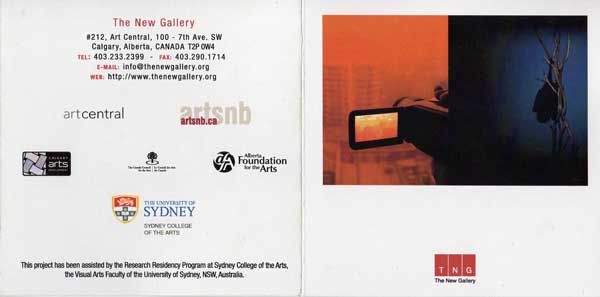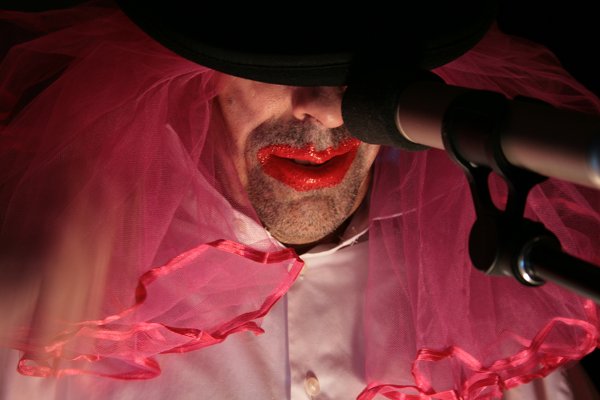Output-Input/EMMEDIA (2017)
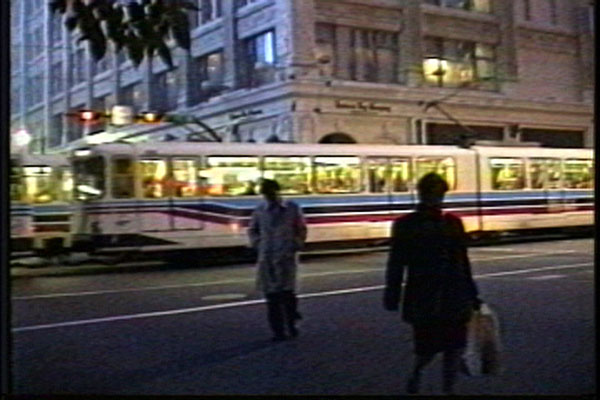
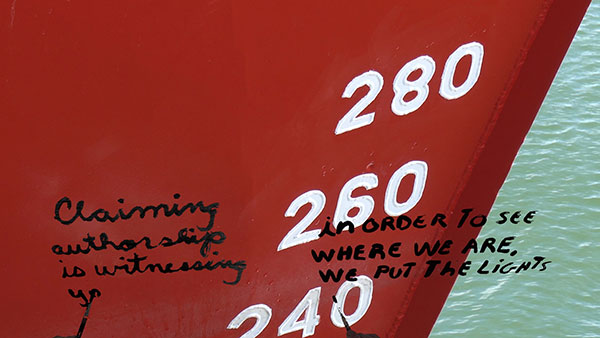
Our (Valerie LeBlanc and Daniel H. Dugas) collaborative videos Illumination (2016) and Work and Love (1990 – part of Slices of Life) have been selected for the Output-Input exhibition. EMMEDIA Member’s Retrospective Exhibition runs: July 14 – August 26, 2017.
EMMEDIA has been a place where media arts lives for almost 40 years! Having recently moved into our new location with two new presentation spaces, we will be featuring work by past and current members and artists, showcasing the rich history of media arts at EMMEDIA. A group exhibition will be featuring established media artists who have laid the groundwork and foundation, alongside emerging media artists that will be shaping the future of EMMEDIA. A formal screening will be presented during the opening reception featuring works from the 1980s – present, with some produced right here at EMMEDIA. We end the night with live performances by prominent audio artists in our community. The exhibition runs until August 26 with the screening available for viewing on the digital screens at EMMEDIA. Come celebrate the media arts community in our new location!
Opening Reception Schedule:
Doors @ 7PM
Screening @ 7:30PM
Artist Q&A @ 8:30PM
Live Performances @ 9:30PM
Peformances by:
Chris Dadge + TBA
Whitney Ota + TBA
Installations by:
Tom Andriuk
Noel Bégin
faxingmyfriends (Teresa Tam, Jadda Tsui, and Sandrine Weltzin)
Lowell Smith
Sandra Vida
Screenings by:
Daniel Dugas & Valerie LeBlanc
Colleen Kerr
Greg Marshall
Lon Parker
Aran Wilkinson-Blanc
http://emmedia.ca/2017/07/output-input-2017/
What We Take With Us – TNG (2012)
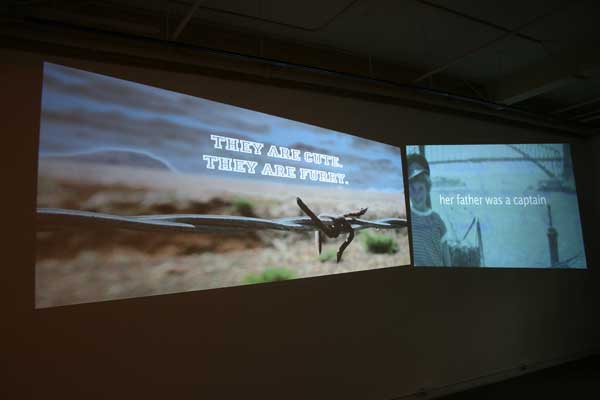
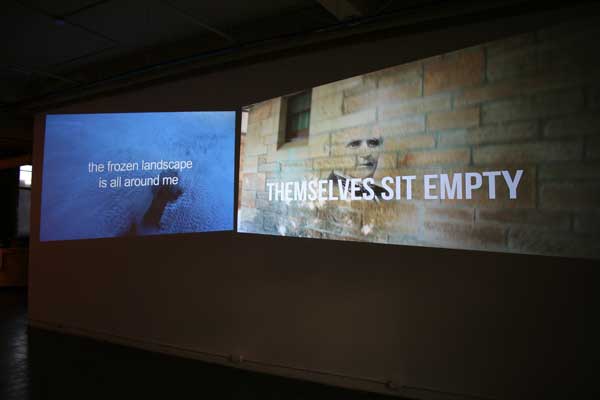
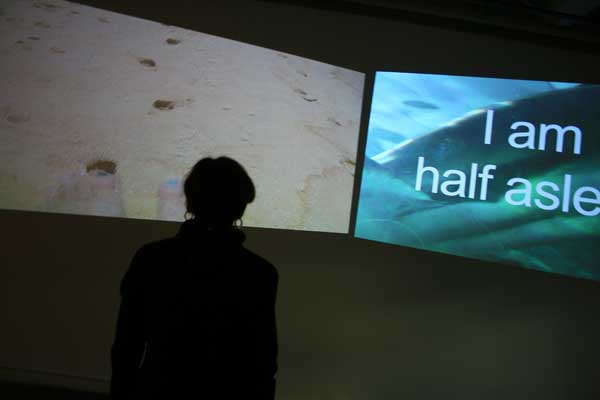
We just came back from Calgary where our video installation What We Take With Us is being presented at The New Gallery. The opening was on January 5th and the exhibition will continue until February 4th 2012. We stayed at the John Snow House which is administrated by TNG. It is an extraordinary place loaded with history.
Thanks to everyone at TNG: Tim, Jessica, Noel, Kathryn, Su, Volunteers – and all who came out to the opening! Our talks will be posted online next week.
Our installation is also part of This Is My City Festival, an interdisciplinary festival of art from the margins.
Excerpt from the essay written by Tomas Jonsson:
Recurrent waves of colonialism and globalization have smoothed and prescribed our encounters with places. For the traveler, points of difference, or of distinction, are sought after, perhaps increasingly so, or patronizingly handed over. Monuments, historical sites and natural landmarks are increasingly oriented to ‘the amused eye’, which the traveler can then compare and develop a discourse “for the comparative connoisseurship of places.”
In What We Take With Us, Dugas and LeBlanc explore a complicated, contingent terrain, whose borders extend into and circumvent geographies, both physical and social, ‘here’ and ‘away’. Encompassing individual catalysts, personal experiences, mental and body memories, the resulting landscape can’t be easily anticipated or defined.
The videos mimic the internal ordering and filtering of places. Each series of vignettes display a personal vision, reflecting the difference in interpretation even by two people so closely aligned. They follow in Dugas and LeBlanc’s collaborative approach in their production and presentation, but in this case the associations are left to chance due to an unsynched running time. The result is a constantly shifting dialogue between the videos, with unknown permutations and combinations.
Booklet for What We Take With Us (2011)
Valerie LeBlanc and I are working on a documentation booklet for What We Take With Us. The video installation will be shown at The New Gallery in Calgary in January 5 – February 4th 2012! Here is a screenshot.

OIL – Beneath the Surface (2011)
OIL is a program of short videos exploring issues and relationships we have with oil, both politically and poetically. I am very happy and extremely proud of the program, the works are excellent and thought provoking. This project would not have happened without the generosity of all the artists involved, and all of the work by Vicki Chau and EMMEDIA. I would like to thank everyone for his/her willingness to be part in this!
The screening is tonight TUESDAY, JULY 12, 2011 @ 7PM at EMMEDIA:
#203, 351 – 11 Ave. SW Calgary, Alberta T2R 0C7
Link to download Program Brochure with Daniel Duga’s Curatorial Statement and Artist Biographies
Videos in the program in screening order:
“Oil (Excerpt)” by Peter Aerschmann (Bern, Switzerland)
“OIL’D” by Chris Harmon (Brooklyn, NY)
“BASIN” by David Geiss (Victoria, BC)
“SCAPE” by Kyle Armstrong & Leslea Kroll (Edmonton, AB)
“A Flood and then some Desert” by Kent Tate (Shaunavon, SK)
“Paper Moon, Cardboard Sea” by Valerie LeBlanc (Moncton, NB)
“Tar Sand Pudding” by Xstine Cook (Calgary, AB)
“Lux Aeterna” by Jacopo Jenna (Firenze, Italy)
“Palabras Negras (black words)” by Anthony Gasca (Montreal, QC)
“OILSPILL – The Human Ueberfluss (Trailer)” by Andy Fox & Jo Blankenburg (Salzburg, Austria)
“OIL” by Maayke Schurer (Kingston, ON)
“Petrolena” by Mark Olin (Titusville, PA)
OIL @ EMMEDIA (2011)
Presented by EMMEDIA Gallery & Production Society
Curated by Daniel Dugas
Deadline: June 1, 2011 @ 4:30PM
Oil. It fuels our cars, it furnishes our homes, it feeds our debates, our wars. Oil, almost magic, which can be transformed into a multitude of products, toys, fertilizers, carpets, shampoo, insulation, golf balls, credit cards, lipsticks, plastic bags, bottles. A strange philosophers’ stone giving immortality to pop bottles and plastic forks.
How are we going to negotiate our dependency and oil addiction with our environmental concerns? Who defines the Industry practices? How can the individual contribute to the emergence of solutions? What is the role of the artist, writer, poet?
OIL is looking for slick short videos to fuel the discussion! Daniel Dugas will curate the program, through a call of submissions that is open to local, national and international artists. We are looking for videos that address and explore the issues and relationships we have with oil, either politically and/or poetically. The program will be screened on July 12, 2011, which is the one-year anniversary of the capping of the BP well in the Gulf of New Mexico.
To submit your short film/video:
– Must be under 5 min.
– Must be submitted on either data DVD as a .mov file or Mini DV, if sending by mail.
– A .mov file can be uploaded onto our FTP server (Please contact programming@emmedia.ca for more details)
– Must not be an original copy as EMMEDIA will not accept responsibility for loss of, or damage to any submissions.
Please note:
– Submissions will not be returned unless accompanied by a SASE.
– Artists will be contacted if selected. Please no phone calls.
– If you are selected, screening fees will be paid in accordance with the Independent Media Arts Alliance (IMAA) fee schedule.
Please send your submissions to:
Attn: OIL submission
EMMEDIA Gallery & Production Society
#203, 351 – 11 Ave SW
Calgary, AB
T2R 0C7 CANADA
All submissions must be received by EMMEDIA on Wednesday, June 1, 2011 @ 4:30PM. Postmarked or late submissions will not be accepted.
For more information, please contact Vicki Chau, Programs & Outreach Coordinator, at:
1.403.263.2833
Curator Bio:
Daniel Dugas is a poet, musician and videographer. He holds an MFA, Time Arts from the School of the Art Institute of Chicago. He was an artist in residence at: the Banff Centre, in both in the Visual Arts and in the Music Department; Sculpture Space, New York; EMMEDIA, Calgary; A.I.R. Vallauris, France, and more recently at the Sydney College of the Arts, Sydney, Australia.
His sixth book of poetry: Hé!, was published last spring by Les Éditions Prise de Parole, Sudbury, Ontario. This spring, he will be participating in the Festival international et Marché de Poésie Wallonie-Bruxelles as well as the Frye Festival. Daniel is currently living in Moncton, New Brunswick where he is pursuing a PhD in creative writing at the Université de Moncton.
Camille, Andrew, Katrina & Co, an essay By Tomas Jonsson (2010)
NECESSARY FICTIONS
Tomas Jonsson
There is a quote by Steve Rienke, the source for which I couldn’t find when I wrote this, that goes something like this: “Critical reviews often rely on an autobiographical experience to instill a personal connection to the work in question, a strategy operating with a mistaken assumption that this imbues the review with meaningful insight.” Implied in his criticism of subjective criticism is that it mistakes the object under interrogation. The suggestion is that critical writing should be more about the art object than about a personal experience of a work of art. Irecognize that I am often guilty of this, and after reading Rienke, I have made an effort -not always successfully- to adopt other strategies.
It is true that inserting oneself within the fabric of a critical response can be too easy a strategy, and often runs the risk of being less interesting than the work under discussion. Sometimes, however, the act of viewing is a subject of the work, and, when one viewer sees multiple works he or she is at the hub of a complex web of associations and judgments. Such is the case in my viewing of Nelson Henrick’s Failure, (2007, 7:00 minutes) and Daniel Dugas’ Camille, Andrew, Katrina and Co. (2008, 109 minutes). These two videos were screened at two distinct occasions as part of EMMEDIA’s CRASH! Narrative Explorations series. Beyond their obvious relation to the larger programming theme, something in the works sparked my curiosity, a sense that these works could speak to each other, that their respective strategies and explorations could offer some shared insight; a simultaneous push and pull at the borders of the conventions, and their personal identities that they worked with, and within. Both also implicate the viewer in the act of viewing, and challenge -subtly and overtly- passive reception of what we are witnessing.
Subtitled “self portrait 61,” Nelson Henrick’s Failure suggests an exhaustive interrogation of the artist. If the previous 60 video portraits (and perhaps more that follow) exist, this is the only one so far to surface for public presentation. It begins with Henricks lying on the floor while a melancholic piano from a Nina Simone song plays. In several shot cuts we then see him peeking out from over a kitchen counter and table, and then lying on the bed. The screen goes black before we hear him sigh and say ‘I think that is ok.” A conscious slip of editing that begins to trouble our acceptance of what we are receiving. In the second segment of this video, we see Henricks shaving, first his beard and then his legs, while the following subtitles play out:
Insert subtitles in this section
Text refers to events in adolescence
That inspired the action onscreen
But not in an obvious way
Keep it open-ended and ambiguous
Make the titles go on long enough
To preserve the integrity of the long take
Keep the performative gesture unedited
While also distracting the spectator
From their boredom
Or find another strategy
Like go to a cut-away
The subtitles reflect the actions on screen. We are left to imagine our own interpretation of the adolescent acts hinted at in this ritual (or why, for that matter, Henricks shaves his legs with his pants still around his ankles).
Following the scripted cut away of scene two (a long holding shot of the humming razor) the view shifts to a record player, and the needle positioned to a fragment of a Serge Gainsborough song, where a woman’s voice lustfully and repeatedly whispers ‘nelson’, the needle is lifted immediately following her third and last utterance of the –his- name. In the next scene, Henricks emerges awkwardly from behind a curtain in a photo studio and performs an equally awkward shuffle to a tune by Pavement. “Special Guest star” Benoit Chasse appears with a handwritten sign that reads “impoverished aesthetics”. A few very rapid cuts follow, in tune to the skipping of the audio track. Despite what this audio tic immediately suggests, none of this is accidental, but rather carefully constructed. These cuts offer a fleeting glimpse of Henricks engaged in the production of this work (setting up lights, etc.), before we return to see him again lying melancholic on the floor as the Nina Simone song plays out, extending into the credits.
Failure is coated with a thick ironic sheen. It reads like a challenge, offering a seductive possibility of inference while at the same time mocking any attempt at reading insight to Henricks’ exploration of identity, and any presumed failures, try as we might. How and where do we attribute failure? Is the performative ritual of shaving symbolic of the inferred adolescent events; a failure to align with gender conventions? We can’t confirm the readings as true regarding the subject outside of the video, but that does not prevent us from wanting – wishing – to know something of him through this construction.
Daniel Dugas’ Camille Andrew, Katrina and Co. exists in several formats, including a website, publication and script. The DVD version is presented in eight chapters and features optional English subtitles that mirrors the French voice that both informs us what we are seeing and provides all the character voices. At times, the visual narrative does not align with the verbal / textual description, and the results are jarring. It is as if the camera cannot keep up with the direction, or instead pursues its own aesthetic concerns. The imagery has a dream-like quality which plays out at a slow, relaxed pace, even during scenes of violent conflict or struggle.
The story follows the conventions of a crime scene drama— immediately familiar to anyone with a steady diet of televised crime shows like CSI—with some magic realism thrown in for good measure. The video employs continuous foreshadowing of the events to come, and cliffhanger endings to the episodic chapters. At times, it seems that the narrator has ambitions that cannot be realized by the constraints of the hand-held video and foley sound. There is a subtle irony to this voice-over; we don’t quite believe it. It takes us in and out of the story, reminding us that we are watching a construction. Perhaps this is a screen test for a later, more realized version.
There are a few stylistic flourishes, such as when we are drawn in to regard a painting of a ship in a storm. The camera moves into focus on one figure who, the narrator informs us, notices us, and who then begins to move up, floating or flying into the oncoming storm. The painting is in the house of Ted, who we come to recognize as the protagonist. He is cooking eggs in the kitchen of his 1970s bungalow (we are told). Over time, we come to learn more about him: his job at an insurance company; the convention he is to give a speech at; as well as larger, sinister forces that he will soon contend with as the (fore)shadow of an upcoming hurricane approaches.
We are only presented the characters in fragments. Dugas does double and triple service performing many of the characters, distinguishable only by their clothing or through representation of their actions. A conversation between Ted and his wife Suzie, for example, is only represented by their respective cups of coffee.
At the end credits, footage taken from houses destroyed from the real hurricane Katrina play out, and we are reminded this is not merely content fodder for a dramatic thriller. In the real world there were no industrious children (Ted’s son, Teddy and his friends) that saved New Orleans, and it is safe to assume that a convention of hurricanes did not plot out the damage to descend on this city. Thinking back on this piece, what can we take from this story and bring towards an understanding of the real events?
Both videos are self-conscious about the conventions of video; neither hide the construction of their form and content. Any engagement we might feel is continually subverted by our awareness of the external frames. These videos are performances. It means something that we recognize the role the artists play in this construction. In my search for the elusive quote by Steve Reinke, I did find this one, which makes this point plain:
“Through video, figures that were previously just functions of the text can be physically embodied in ways that radically undermine the stability of authors in relation to their texts and narrators. Video artists can be positioned both interiorly and exteriorly (behind and in front of the camera) to their texts in a way that is impossible for writers, who must always, despite all their desperate efforts to the contrary, remain off-page.”1
Reading this, I was reminded of watching Adaptation, a movie that, like these two videos, exposes filmic and narrative convention even as it follows it. In the climatic finale -an absurd battle between the protagonist, played by Nicholas Cage and a crocodile- induced hysterical laughter from myself and my friend, to the annoyance of others in the theatre who were more willing to go along with the story.2
As Reinke notes, video is more amenable to this kind of slippage. It can create a space where the real and the fiction can co-exist in a tense ambivalence that destabilizes the comfort of suspended belief. While these two works subvert the conventions of conventional filmic narrative, this subversion does not counteract but rather gives new life to tired, often meaningless, conventions. Through this tension we shift from passive viewers to active participants in the construction.
Of course, this terrain is well covered. I’m conscious that a comparative analysis of two works could be made of any number of tapes, and is in itself perhaps a banal strategy. With this risk in mind, these works, exposed to me over time and space, nevertheless instill in me a nagging thought that results in an impulse to translate this to print.
________________________________________________________________
1. Nelson Henricks’ Failure was screening on November 25th, 2010 along with Deborah Stratman’s O’er the Land. Daniel Dugas’ Camille Andrew, Katrina and Co. was screened on May 14, 2010
2. I would like to thank Donna Wawzonek for reminding me of this incident.
Download the full version of IMPACT STATEMENTS
© 2010 EMMEDIA Gallery & Production Society
All Rights Reserved
All rights reserved. No part of this publication
may be reproduced or transmitted in any form
without prior written permission from the publisher.
Library and Archiving Canada
Cataloguing in Publication
IMPACT STATEMENTS:
CRASH! Anthology of Critical Texts
ISBN 978-0-9737962-9-2
Published by
emPRESS
EMMEDIA Gallery & Production Society
#203, 351 – 11 Ave SW
Calgary, AB
Canada T2R 0C7
1-403-263-2833
www.emmedia.ca
Edited by David Garneau
Project managed by Tomas Jonsson
Design by Vicki Chau
Printed in Canada by Emerson Clarke Printing
Screening tonight (2010)
Camille, Andrew, Katrina and Co. is a story based on the personification of hurricanes. The ‘old storms’ Katrina, Ivan, Andrew and Camille come to shore in Pensacola to prepare the ground for the next hurricane. Ted, the hero of the story, finds himself involved in all these machinations and attempts to save his city from certain disaster.
Friday, May 14th, 2010 @ 7 PM
EMMEDIA Screening Room
EMMEDIA Gallery & Production Society
#203
, 351 – 11 Ave. SW.
Calgary, Alberta T2R 0C7
Prairie Tales 10, Alberta Film and Video on Tour
I drove, this first weekend of spring, to Fredericton, New Brunswick to screen the 10thedition of Prairie Tales. The NB film Coop, who was hosting the presentation, has been a supporter of the project for some time. The cultural centre, where the Coop has its offices, was very busy as there were a number of others events happening in the building concurrently. This abundance of activities probably contributed to a smaller turnout. Nevertheless one member of the audience drove over two hours to see the works! And that is saying a lot as the highways were invaded by hordes of deer!
One of the things I love about Prairie Tales is its diversity of genre and approach but what really strikes me, this year as in previous years, is the creative energy and artistic ability that can be found in Alberta. By viewing the program one can feel that there is a vigorous discourse that is being nurtured. The screening prompted discussions about film, video, networking, and the media arts across Canada.
In the darkness of the Doodles Café, where the screening took place, I felt something that I never felt before. As I was looking at the program, I was seeing markers; landscapes, back alleys of Calgary and Edmonton, and in this familiarity of surroundings, I felt homesick! Alberta, and more specifically Calgary, has been my home, on and off, for over 15 years. I have recently relocated to Moncton, New Brunswick, my other home. I am very proud to have been part of this year’s selection but I also feel privileged to have been able to contribute to the artistic vitality of the amazing place that is Alberta!
March 30, 2009 -Moncton NB
Prairie Tales 10
The latest collection of short film and video works by Alberta media artists.
Presented by Edmonton’s Metro Cinema Society.
This is art VS This is not art (2008)
8:44 am
The cold is intense. My walk to the College is like an expedition. My head is in there, somewhere under the layers. As I breathe frost is forming on my scarf and face. I feel the cold creeping into my fingers and back. It is starting to get in through my boots. Under my hood, all I hear is the resonating squeak of my footsteps like a walk in Styrofoam moon boots. It hurts.
8:49
The SAIT campus is already bustling with people. We look like steam engines, puffing white clouds of life that freeze in mid air. I think it’s minus 40C.
Choo! Choo!
8:52
Horror! I spot a conductor/student walking leisurely. His steam is thick like molasses. He isn’t even wearing a tuque. He has a jacket with a hood but he is not covering his head! His face is calm. The man appears to be immune to pain. I am thinking, he looks like me in July…
8:53
As I continue, I think that the man must have lost his power of thought. Then, it strikes me that I am witnessing a performance, an art performance. As Laurie Anderson once played violin while her standing with her ice skates frozen into a block of ice, I interpret that this man was doing something amazing. I just didn’t realize it at the exact moment.
8:57
I arrive – I have made it! I am finally at ACAD. The warmth of the mall hits me like a wall of bliss. Others have arrived at the same time; all look stunned by the brutality of the cold. We move slowly while our clothing regains some sort of flexibility. The mall is filled with the wonderful works of the First Year Studies Exhibition. Near the elevators, there are a few men kneeling down beside their buckets of cement. They are busy repairing broken tiles and have set up a barricade with yellow tape.
9:36
On my way to the Faculty lounge I notice that the monitor of the Diversity booth, which sits in the middle of the Mall, is sporting a black label stuck in the middle of the screen. The label has been made with an old label maker and the white letters state: THIS IS NOT ART. I gaze around the mall before reading the label again. My first thought is that the label points conceptually to surrealist René Magritte’s painting, The Treachery Of Images*. This is after all, an Art school, throbbing with ideas. Satisfied, I continue to the Faculty Lounge. Then…
9:49
I have this weird feeling that maybe the statement on that label was not so layered, not so complex. Maybe someone, here in the innards of this laboratory, needs to have things labelled according to the TELL ME WHAT IS THIS book.
10:31
Time flies. My Sound I class is finishing the set up for a laptop performance in the arthole. Things are going well in the placement of two tables, a P.A. system, and with an orderly jungle of cables and adaptors, 8 laptops have been wired up and are ready to go. Tim from the AV has been helping us. The idea for our performance is to sample sounds with a microphone and create real time loops with the material. As there are 8 loops created at any moment it becomes clear that this is as much a sonic experimentation as an exercise in listening.
11:12
We have been creating texture and rhythm for 30 minutes now. Some of the results are curious, some are engaging, and some make for difficult listening.
11:13
The group has developed a minimal soundscape, almost inaudible, which makes the ghetto blaster of the café overpowering. After a while I decide to ask the café staff to lower its music. The person I ask looks at me without speaking. Without words, the message to me is of the unhappiness of being forced to listen to sound art. The unspoken words might be that the sound experiment is cutting into the musical dreamscape. I thank him for lowering the sound of the ghetto blaster.
11:14
On my way back to the laptop area, I realize how bizarre this non-comment is. I mean this is an Art school. This is a ‘laboratory environment that is committed to unconstrained inquiry’. I begin to wonder many students, here at school, boast a dislike for abstract painting over landscape painting, or for curved shapes over square angles, or for lights that are not of the hue prescribed in the TELL ME WHAT IS THIS SO I CAN MAKE SENSE OF IT book. If there is aesthetic intolerance here, one can only imagine how dangerous it is outside of the lab.
11:40
The performance is over. We have taken all of the equipment down. On our way back to the fourth floor I notice that the workers who were repairing the broken tiles are gone. They have left warnings on the barricade. The warnings state: DO NOT TOUCH. THIS IS NOT AN ARTWORK.
11:40:02
YIKES! Is this another Treachery Of Images or is it just the steam from our mouths making it difficult to see? It is not yet midday and the opportunity to generate dialogue has raised its head three times.
Daniel Dugas
* The Treachery Of Images (La trahison des images 1928-29) is a painting by Belgian Surrealist painter René Magritte, famous for its inscription Ceci n’est pas une pipe.
NB – All of these events took place, not exactly at the times stated here.
Are you ready? (2008)
ARE YOU READY?
David McCallum is a musician and a media artist from Toronto. His day job is editor of Musicworks Magazine, his passion is to discover new terrains. With a background in physics, music composition and new media, he is one of the new breed of explorers that bring science and art together. McCallum has a diverse body of work that encompasses music, performance, locative media, video, net art and installation. The motivation behind all of these works is an insatiable curiosity, a desire to experiment and to share his discoveries with diverse audiences.
LOCATIVE ARTS
In the last few years, we have seen numerous projects rooted in geometry, location and psychogeography. Projects with names like Geograffiti, Sound Mapping, Urban Tapestries, and GPS Drawings. All of these are locative art, meaning that they use location-based media such GPS or Wi-Fi as the medium. WARBIKE, one of McCallum’s most important works to date, is such a project. It is a bicycle with a clear plastic container attached at the front, loaded with electronics that sonify computer wireless networks. As the bicycle rider cycles around town, the electronics pick up nearby Wi-Fi signals and turn them into squeaking sounds based on the strength of the signals and the encryption status of the network. There are two types of wireless networks, those that are encrypted and those that are not. If the initial motivation of McCallum was to draw attention to the level of safety of any network, the most important effect of his project is to make the participants aware of this invisible layer of communications that is floating in our public spaces. Those invisible networks of information are now ubiquitous in our urbanscapes. McCallum points out:
“Did you know that almost anywhere that you go in a city you’ll be sharing space with someone’s private wireless computer network? All of their personal communication—e-mail, love messages, bank passwords, credit card numbers, and bizarre surfing habits—will be passing through your body without your awareness. Who are they, and how do you feel about sharing space with their personal life?”
The image of emails and love messages and even passwords and bank accounts passing through bodies has an undeniable poetic weight but it also raises important questions about privacy and free access to information. One of the big questions is how can an Open Society be built around private networks? This concern is also McCallum’s, as a volunteer for wireless Toronto, a not-for-profit group promoting no-fee wireless Internet access.
Popular geotagging software like Google Earth has help fuelled a passion for anything location. Locative arts projects are sprouting everywhere and McCallum continues to question and to negotiate their relevance and problematic. Can we compare the WARBIKE rider, seeing and feeling what is around, to the fox in the Little Prince? Is the rider seeing the invisible? Is the essential located only in the hip downtown core, in the Hotspots of our cities? Can this abundance of information that is surrounding and enveloping us all the time keep us warm at night? In a recent email exchange McCallum stated:
“I’m no longer explicitly interested in pursuing purely psychogeographic things. I’d like to focus more on the experience of people within spaces, be they urban or not… There’s also been a bit of a fall out, at least in Toronto, with the psychogeographic community. Those who were only casually interested, like me, are starting to realize that to truly understand the workings of the city, one must look beyond the hip downtown core and into the rather unhip and desolate suburbs. I’m not sure that this is anything that any of the core psychogeographic boosters are terribly interested in, or are even equipped to handle. This isn’t even taking into account the drudgery of city planning where the reality involves budgets and garbage pail infrastructure and other incredibly tedious but necessary components to a city. And then there’s also the slightly cultish nature of public space boosterism, or the class division between those who have the luxury to spend time worrying about public space and those who do not.”
When in 1897, Guglielmo Marconi sent the first wireless communication message over water, he could never have imagined the complexities of our encrypted digital age. The message, sent from Lavernock Point, South Wales to Flat Holm Island, a distance of 14 kilometres, was simply “Are you ready”. 110 years later, it looks like this message is still resonating through space. Are we ready?
PD & Do-it-Yourself attitude
David McCallum is coming to Calgary to give a workshop on PD , which he uses for music. PD, aka Pure Data, is a real-time graphical programming environment for audio, video, and graphical processing. Miller Puckette developed the program in the 1990s for the creation of interactive computer music and multimedia works. One of the great advantages of Pd over Max Msp, a similar program, which also originated from Puckette, is that Pd is a freeware.
McCallum is an advocate of the open source movement and of the do-it-yourself attitude. He does have strong convictions about the craft of new media art and the importance of doing the work by himself or with his collaborators. David sometimes works with the i/o media group, a collective of media artists exploring real-time improvisation performance . He also is capable of looking at technological apparatus and using it in novel ways. His performance i swallow is a good example. The MacBook’s design has the mic and webcam directly beside each other. McCallum can play the feedback through the microphone while the webcam captures his actions. This dual process allows the audience to see a connection between the sound and his actions—something, McCallum says is lacking in most electronic music performance.
David will be at EMMEDIA Friday, January 11, 2008 – 7:00 PM to present his project WARBIKE. He will also be giving a Pure Data Introductory Workshop January 12-13, 2007, Noon – 5:00PM.
For more information call 263.2833
1. David McCallum websites includes:
http://www.mentalfloss.ca/sintheta/projects/?
http://sintheta.blogware.com/
2. On a technical level, the ‘sniffing’ is done by Kismet, a wireless network detector, the audio by Pure Data, and Python is acting as an interpreter between two.
3. David was the editor of the Locative Technologies issue (March 2007), digital arts quarterly magazine, vague terrain. For more info:http://www.vagueterrain.net/content/archives/journal06/journal06.html
4. Pure Data: http://puredata.info/
5. http://www.mantissa.ca/iomedia/
6. i swallow was presented earlier this year at the Pleasure Dome’s New Toronto Works Show and at Interaccess both in Toronto.
YouTube: http://www.youtube.com/watch?v=wOknyZ7QHM0
Text published at EMMEDIA Gallery & Production Cociety
This fall Daniel Dugas has been touring his real time network performance Free Market Karaoke in Mexico City and on the East coast. He was also invited to the Trois-Rivieres Poetry Festival where he read from his latest book ‘Même un detour serait correct’. Daniel works and lives in Calgary.
Daniel H. Dugas
Archives
Blogroll
- A.I.R. Vallauris
- ACAD
- Adobe additional services
- Adobe Creative Cloud
- AIRIE
- Amaas
- Amazon Author Central
- ARTothèque
- Australian Poetry
- Basic Bruegel
- Bitly
- CCCA
- CDBaby
- Cycling 74
- Dissolution
- Éditions Prise de parole
- Emmedia
- eyelevelgallery
- FAVA
- Festival acadien de poésie
- Festival FRYE Festival
- FILE – Electronic Language International Festival
- Freeware list
- Fringe Online
- Galerie Sans Nom
- Gotta Minute Film Festival
- Instants Vidéo
- JUiCYHEADS
- Kindle Direct Publishing
- Klondike Institute of Art and Culture
- La Maison de la poésie de Montréal
- La Maison de la Poésie et de la Langue française Wallonie-Bruxelles
- Laboratorio Arte-Alameda
- Le Centre Jacques Cartier
- Liberated Words
- Maison Internationale de la Poésie – Arthur Haulot
- MediaPackBoard
- Miami Book Fair International
- Monoskop
- Mot Dit
- NSCAD University
- Paved Arts
- PoetryFilm
- Portail des auteurs du Nouveau-Brunswick
- RECF
- Revue Ancrages
- Salon du Livre du Grand Sudbury
- Sculpture Space
- Subtropics.org
- Sydney college for the arts
- The Centre for Contemporary Canadian Art
- The New Gallery
- Trevigliopoesia
- tumbler-documents
- V Tape
- Valerie LeBlanc
- VideoBardo
- Void Network-Κενο Δίκτυο
Categories
- #covidpoèmes
- Advertisement
- AIRIE
- Ancrages
- anthology
- Anthropocene
- Architecture
- Around Osprey
- art
- Article de presse
- arts visuels
- audio
- Australian Poetry
- Basic Bruegel Editions
- Book
- book fair
- Cafe Poet Program
- Ce qu'on emporte avec nous
- Citations gratuites
- Collaboration
- commentaire
- commentary
- Compte rendu
- conférence
- Conservation Foundation of the Gulf Coast
- COVID-19
- Critique littéraire
- culture
- Daniel Dugas
- Design
- Édition Michel-Henri
- Éditions Perce-Neige
- Éloizes
- Emmedia
- emoji etc | émoji etc
- Environnement
- essai
- essay
- Everglades
- Exhibition
- festival
- Festival acadien de poésie
- Festival Frye Festival
- FIPTR
- Flow: Big Waters
- Fundy
- Habitat
- installation
- Instants Vidéo
- interactivity
- journal
- JUiCYHEADS
- Kisii
- L'Esprit du temps
- laptop
- Leaving São Paulo
- lecture
- Livre
- logos
- Magazine
- Miami Book Fair
- Moncton 24
- novel
- OASIS
- oil spill
- perception
- performance
- Photo
- poésie
- Poetic Licence Week
- Poetry
- politics
- politique
- press
- Prise de parole
- Revue Ancrages
- salon du livre
- sculpture
- Sculpture Space
- sound
- Souvenirs
- Spirit of the Time
- Style & Artifacts
- Symposium d'art/nature
- talk
- television
- The New Gallery
- Uncategorized
- Valerie LeBlanc
- vidéo
- vidéopoésie
- Videopoetr/Vidéopoésie
- videopoetry
- visual arts
- What We Take With Us
- youth literature






